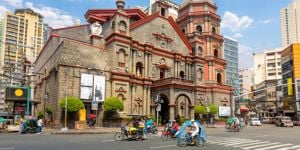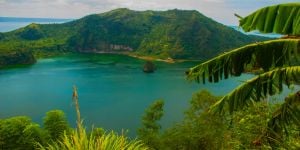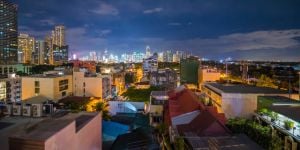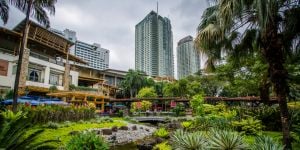
Retiring in the Philippines can be an exciting prospect for expats. Settling down in the Philippines has its advantages for expat retirees; a more cost-effective way of living combined with a tropical paradise! The cost of living in the Philippines is comparatively cheaper than in the US or Western Europe. Provided you have the financial means and an open mind to exploring a new country, then the Philippines may be the place for you!
Let's look at the benefits of retiring to the Philippines, how to apply for a Philippines Retirement Visa (SRRV), where to reside, is the Philippines safe, health risks, and of course, how to maintain your health and well-being as an expat.
Benefits of retiring to the Philippines
As mentioned above, there are many benefits to retiring to the Philippines, including the following:
- The Philippines tries to adopt a Westernized way of living where possible
- English is spoken in most places
- The cost of living is low
- Friendly and helpful locals
- Some of the most beautiful landscapes in the world
- Warm temperatures
- Strict law and order
- Option of urban or rural living, or both
- Fresh fish, fruit and vegetables are in abundance
- Transportation is readily available
How to apply for a Philippines retirement visa
You can apply for a Philippines retirement visa under the SRRV program if you are at least 50 years old and have a pension or if you are at least 35 years old and make a deposit of at least $50,000, plus you have no criminal record.
A Special Resident Retiree's Visa to the Philippines (SSRV) can be obtained by foreign nationals who wish to live, retire, or invest in the Philippines indefinitely or permanently. SSRV holders also enjoy multiple-entry privileges, as well as tax-free pensions and annuities remitted to the Philippines.
Foreigners who are at least 35 years old and without a criminal record or pending court case can apply. They should not be deemed “restricted” or disallowed from entering the country by the Philippine Department of Foreign Affairs. Those who have overstayed in the Philippines or otherwise violated Philippine immigration laws and are under a Black List Order (BLO) are barred from applying for an SSRV.
Choosing your retirement visa
To choose the correct retirement visa for your needs, the Philippine Retirement Agency (PRA) offers four types of SRRVs:
SRRV Smile
For active and/or healthy applicants aged 35 years and older, a visa deposit of USD 20,000 in a PRA-accredited bank must be maintained for as long as they remain an SRRV holder. No retirement pension is needed.
SRRV Classic
The required visa deposit is as follows:
- USD 10,000 to 20,000 for active and/or healthy retirees aged 50 and above
- USD 50,000 for applicants aged 35 to 49 years old
The deposit can be requested for release for an approved investment 30 days after an SSRV is issued. Approved investments include condos and lease of land and real estate for long-term use. Please note that the value of the property must be at least USD50,000. Both are ways for foreign retirees to acquire a home in the Philippines.
SRRV Courtesy
This visa is open to former Filipinos at least 35 years of age and foreign nationals aged 50 and above with a history of serving in the Philippines as ambassadors, diplomats, or officers and staff of international organizations. The required visa deposit is USD 1,500 with up to two dependents. SRRV Courtesy deposits can also be converted into investments.
SRRV Human Touch
This option is for applicants with pre-existing (non-contagious) illnesses who may need medical and/or clinical assistance. Requirements include a USD 10,000 visa deposit, health insurance that is accepted in Philippine hospitals, and a monthly pension of at least USD 1,500.
Visa deposits only cover the applicant and up to two dependents, like a spouse or children. A supplementary deposit of USD 15,000 is required for every additional dependent. These deposits can also be converted to investments.
If you choose not to invest your money, you can get your deposit back when you decide to leave the SRRV program or switch to another type of visa.
Open a USD bank account
SRRV applicants have to open a US dollar time deposit account in any bank accredited by the Philippine Retirement Authority with the amount required for the chosen visa option. The bank will issue a time deposit certification of inward US dollar remittance, which is needed for the steps that follow.
Submit the required documents
For the principal applicant and accompanying spouse and/or dependents, submit the following documents for authentication by the Philippine Embassy or Consulate. (All documents must have an accompanying English translation):
- Accomplished PRA application form
- Original passport with valid entry status
- Medical examination clearance
- Clearance from the Philippine National Bureau of Investigation (NBI) or a police clearance from the applicant's country of origin.
- 6 copies of 1″x1″ and 2″x2″ ID photos
- The bank certification issued in STEP 2
- NBI clearance (if the applicant has stayed in the Philippines for more than 30 days from the last date of entry prior to applying for an SRRV)
Processing and service fees are:
- USD 1,500 for principal applicant (one-time only)
- USD 300 for spouse and each dependent. (one-time only)
- USD 10 annual fee for a PRA ID card (the first year is free)
Submit completed documents to the PRA head office
Bring your authenticated documents for evaluation to the PRA Head Office at 29/F Citibank Tower, Paseo de Roxas, Makati City, 1227 Philippines.
Once approved, your documents and original passport will be forwarded by the PRA to the Bureau of Immigration, where it will be stamped with your SRRV.
Where to retire to in the Philippines
Metro Manila
Metro Manila is still the Philippines' central hub for expat retirees. This makes sense as the metropolis is home to world-class hospitals, an exciting lifestyle and leisure options, plus an established and lucrative property market.
Laguna
Proximity to Manila is perhaps Laguna's biggest attraction. Its towns and cities immediately south of the capital boast new developments. These include Ayala Land's Nuvali project in Sta. Rosa City or the residential golf Ayala- Greenfield Estates located on the picturesque slopes of Mount Makiling.
The former is actually an integrated township that includes western-style gated communities, medium- and high-rise condos, offices, and retail shops.
Cavite
Similar to neighboring Laguna, Cavite's proximity and easy access to Manila are two of its major draws, which it uses to its full advantage. The province is highly accessible from the capital either through the South Luzon Expressway from Muntinlupa City or the Manila-Cavite Expressway from Pasay City.
The province is also fast becoming a real estate hotspot, not only for locals and OFWs looking for homes but also for well-heeled investment or leisure property buyers.
Cavite has a number of assisted-living facilities with a dedicated medical wellness program specific for retirees. One of them is Saujana Premiere in the town of Silang, which is positioned as the first holistic wellness center for retirement-age citizens.
There's also the province's famous Tagaytay City, which has been attracting tourists and retirees for years. The city also teems with restaurants, hotels, golf resorts, and many other leisure options. In fact, Tagaytay enjoys the unique characteristic of being both a tourist spot and a retirement haven.
Cebu
The province of Cebu has that unique combination of urban attractions in close proximity to provincial life. The province, especially the Metro Cebu area, boasts top schools, hospitals, plenty of entertainment options, and an international airport.
The province has for years been Central Philippines' main business hub and is now a growing medical tourism destination, thanks to its hospitals. In recent years many large real estate developers have unveiled their own projects in Cebu, such as Megaworld's Mactan Newtown, Ayala Land Premier's,1016 Residences and Alveo's Solinea.
Clark
The increased developments happening in this former Clark U.S. base make it more interesting by the day. Already a top retirement area among Americans, it's also fast becoming popular among locals as well.
The opening of the Subic-Clark-Tarlac Expressway (SCTEX) offered ease of mobility in the greater Clark region, which includes the cities of Angeles and San Fernando and the town of Mabalacat. Depending on the national government's eventual decision, its huge international airport will become the Philippines' primary gateway or one of the two that will serve the Greater Manila Area.
It's no surprise that a number of property developers are setting their eyes on the area. Ayala Land's recently unveiled its Marquee integrated project in Angeles City, which already has a shopping mall and will soon include high-rise condos and gated communities, while local developer Dongwang Construction is currently developing an integrated tourism estate called Clark ODE County.
Subic
Located on Luzon Island's eastern side is Subic Bay, renowned for wreck diving, adventure parks, and, just like Clark, for being a former US overseas military installation. However, its wrecks and nature trails aren't its only attractions; its American-style suburban lifestyle, complete with private hospitals, good schools, duty-free shopping, hotels and resorts, and lively dining scene and nightlife, make it also quite popular. It's also very accessible to Clark through SCTEX.
Subic is shockingly clean and well-ordered. Traffic rules are strictly enforced, and it has its own police and fire service. However, some expats find the place too sterile, so they opt for its raunchier but more exciting neighbor Olongapo City.
Baguio
Although in recent years, the City of Pines and the country's summer capital has experienced quite a huge dose of commercialization, it has retained some of its old charm. Although the traffic in Baguio can be hellish, the weather and air (depending on the specific location here) are still generally fresher, which is a serious consideration for a retiree.
A major drawback, though, is its distance from Manila, which, even with the improvement of the North Luzon Expressway (NLEX) and the opening of SCTEX and the first section of the Tarlac-Pangasinan-La Union Expressway (TPLEX), is still at least 6 hours away.
Nonetheless, Baguio has the trappings of a highland resort, such as quaint bed-and-breakfast, charming cafés, and fresh produce from neighboring La Trinidad Valley, which made it popular with vacationers and retirees in the first place.
Iloilo
The Greater Iloilo area, composed of Iliolio City and 10 other municipalities, is the Western Visayas Region's hub for trade, commerce, and industry. It is also a booming city for business process outsourcing. As such, its infrastructure is impeccable, starting from top hospitals (the first kidney transplant facility in the Philippines outside Manila), schools, the second most important seaport in Visayas, and its very new international airport.
Property developers have, of course, taken notice. Megaworld will develop the old airport to become Iloilo Business Park and has just launched the 10-story, 156-unit One Madison Place Luxury Residences.
Bacolod
Sugar and Masskara festivals aren't only the major attractions of this Negros city. It's got two major golf courses, and is also a thriving business and BPO hub. It has received accolades for being the ‘best place to live in the Philippines'.
It's also like the Silicon Valley of the Philippines, having been declared by the Department of Science and Technology as a “center of excellence” for information technology and business process management operations. It's not surprising then that the city is attracting quite a number of retirees.
Davao
Culture, nature, business, and fresh produce abound in Mindanao's largest city. It also seems that assimilation has long been its mantra, making it one of the country's most multicultural and peaceful, despite being in restive Mindanao.
Popular Mount Apo, the country's highest peak, is just outside its doorstep, and so are luxury beach resorts on the neighboring Samal Island.
Its real estate scene is as bustling: Ayala Land brought to the city its luxury touch with the Abreeza Place condo project, while FTC Group unveiled its 33-story condo dubbed Aeon Towers, just a stone's throw away from Abreeza.
Is the Philippines safe for expats?
In recent years the Philippines has taken more of a zero-tolerance approach to law and order. Like in any country, expats should always exercise caution with their homes and personal belongings.
Pick-pocketing, begging, scamming and prostitution can be an issue in bigger cities, but on the whole, the local Filipino population is respectful to expats and foreigners in general.
However, the US Department of State advises NOT to travel to; The Sulu Archipelago, including the southern Sulu Sea, due to crime, terrorism, civil unrest, and kidnapping and Marawi City in Mindanao due to terrorism threats and civil unrest.
They also suggest reconsidering travel to other areas of Mindanao due to crime, terrorism, civil unrest, and kidnapping.
Retirees' health and well-being in the Philippines
The healthcare system in the Philippines can be best described as varied. On the one hand, Filipinos living in rural areas don't have access to basic medical facilities; but on the other, people from around the world travel to this country to make use of its high-standard services at fairly low costs.
There are approximately 1,700 hospitals all across the country. About 60% of them are privately owned, and the rest are run by the state.
Like in many other countries, you can choose between public and private healthcare. It is important to know how both work in order to make the choice that is best for you.
Health risks in the Philippines
If you are planning to visit or move to the Philippines as an expat retiree, it is advisable to be aware and prepared against potential health risks. This could include getting immunized against certain diseases and staying healthy.
In the past, mosquito-borne dengue had become endemic throughout the nation. Another disease that poses a major threat to expats is malaria. There is no vaccine for either ailment, and it is, therefore, essential to follow anti-mosquito practices at all times. Carry a mosquito net and some topical repellents everywhere you go. It is also best to cover up as much as you can when going outside.
Water-borne diseases like cholera and typhoid have also been widespread in certain parts of the Philippines. Tap water will make you sick, and it is indicative of the risk that the locals buy 5-gallon filtered water drums for p25 each or bottled water from the supermarket, which has a fresh taste. It is difficult to avoid adding ice to your drinks in a bar or restaurant, but please be aware of the risks. Street food, especially uncooked items, can be very unsafe since the ingredients are not always washed properly. It is important that you seek immediate medical attention if you feel like you are suffering from food poisoning symptoms.
In certain parts of the Philippines, the temperatures can reach extreme levels, and it is always advised to wear sunblock, plan any trips outdoors and hydrate always.
To conclude, if you are well-prepared, open-minded to new cultures, have the financial means, and are aware of the visa requirements and the health system here, we certainly recommend the Philippines as a retirement destination.
Useful link:
We do our best to provide accurate and up to date information. However, if you have noticed any inaccuracies in this article, please let us know in the comments section below.












Comments
1I believe this is incorrect, The SSRV smile for 35+ has been suspended